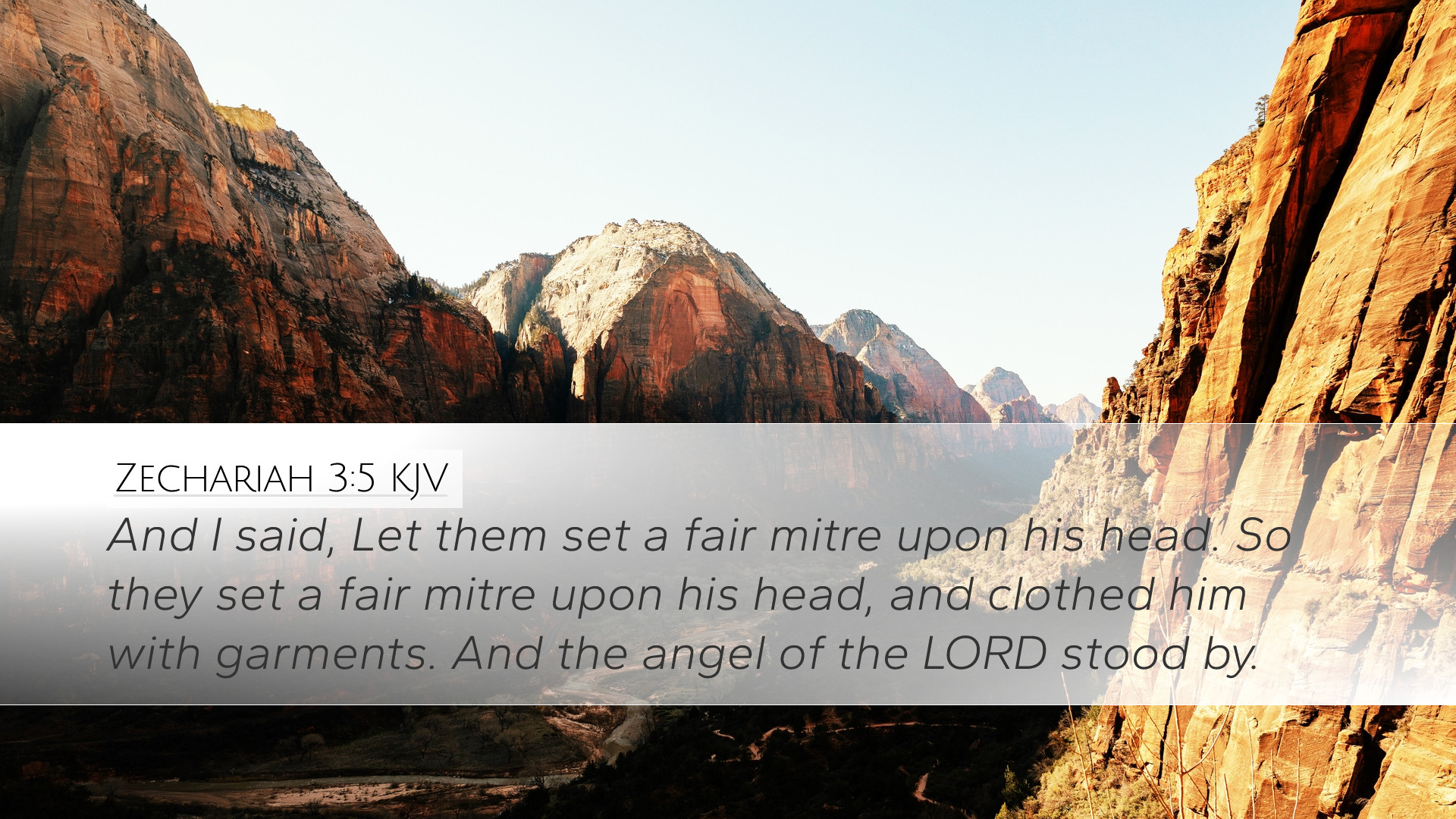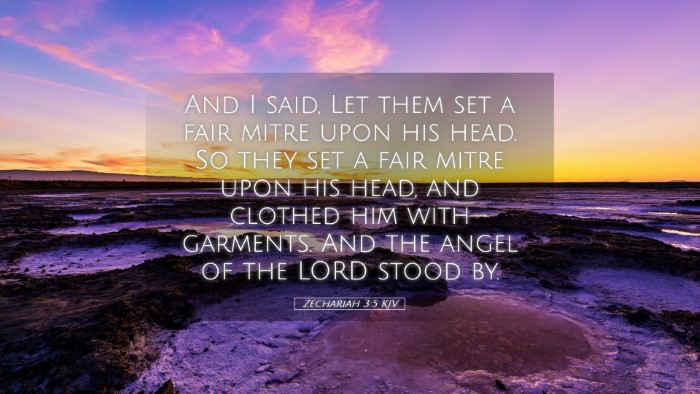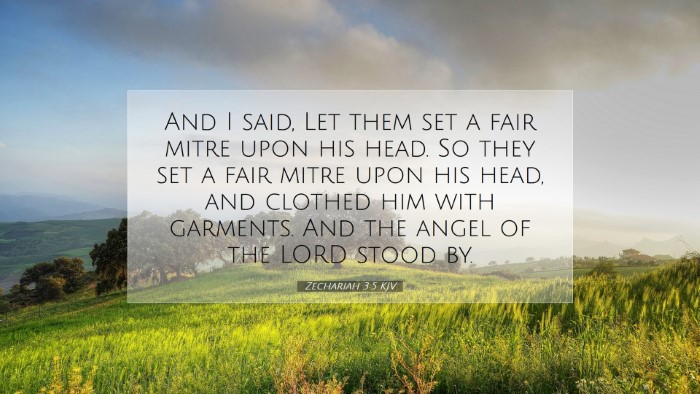Old Testament
Genesis Exodus Leviticus Numbers Deuteronomy Joshua Judges Ruth 1 Samuel 2 Samuel 1 Kings 2 Kings 1 Chronicles 2 Chronicles Ezra Nehemiah Esther Job Psalms Proverbs Ecclesiastes Song of Solomon Isaiah Jeremiah Lamentations Ezekiel Daniel Hosea Joel Amos Obadiah Jonah Micah Nahum Habakkuk Zephaniah Haggai Zechariah MalachiZechariah 3:5
Zechariah 3:5 KJV
And I said, Let them set a fair mitre upon his head. So they set a fair mitre upon his head, and clothed him with garments. And the angel of the LORD stood by.
Zechariah 3:5 Bible Commentary
Commentary on Zechariah 3:5
Zechariah 3:5 reads: "And I said, Let them set a fair mitre upon his head. So they set a fair mitre upon his head, and clothed him with garments. And the angel of the Lord stood by." This verse presents a profound moment in the prophetic vision of Zechariah, where Joshua the high priest experiences a divine act of restoration and preparation for service before God. The insights from various public domain commentaries offer a rich exploration of its meaning.
Contextual Background
The context of Zechariah's prophecy is critical for understanding this verse. The backdrop is post-exilic Israel, a time when the nation was grappling with its identity and spiritual restoration after Babylonian captivity. The priesthood, crucial for mediating between God and His people, was under scrutiny, especially regarding its purity and fitness for service.
Meaning of the Mitre
The "fair mitre" mentioned in this verse symbolizes a few key elements:
- Restoration: As articulated by Matthew Henry, the mitre signifies the reinstatement of Joshua as high priest, indicating acceptance and the restoration of his office after previous defilements.
- Purification: Albert Barnes emphasizes that the placing of the mitre represents not only a physical adornment but a spiritual cleansing and preparation to serve in holiness. The mitre was an important piece of the high priest's attire, signifying sanctification for God’s work.
- Authority and Worthiness: Adam Clarke also points out that the mitre, which bore the inscription "Holiness to the Lord," was a proclamation of Joshua's renewed authority and the call to live in holiness, reflecting God's holiness in his ministry.
The Role of the Angel of the Lord
The presence of the "angel of the Lord" is significant. Scripture consistently shows the angel acting on God's behalf, demonstrating God's intimate involvement with His people. It indicates:
- Divine Advocacy: This angel plays the role of an advocate, suggesting that Joshua is being defended against accusations, as seen in the earlier verses of this chapter. Both Henry and Barnes note that this reflects the larger truth of Christ's intercession for sinners.
- Communicator of God’s Intent: The angel communicates God's plans and purposes for Israel's restoration. Here, it is vital to note that Joshua's reinstatement is fulfilment of prophetic promise, a theme echoed throughout biblical narrative, particularly in the context of priestly service.
The Significance of Clean Garments
The act of clothing Joshua in new garments signals a transformation.
- Symbolism of Righteousness: Matthew Henry comments on the "filthy garments" that Joshua had been wearing. These represent sin and unworthiness, while the new garments symbolize the righteousness provided by God, emphasizing the need for cover from shame and guilt.
- Transformation through Grace: Clarke notes that this transformation reflects a profound grace bestowed upon Joshua—not merely in a ritualistic sense but in a deeply spiritual renewal that allows him to serve God faithfully.
Theological Implications
The events in this verse resonate with numerous theological themes that are pertinent for pastors, students, and scholars:
- Restoration of Relationship: The restoration of Joshua illustrates God's initiative in mending the broken relationship between Himself and His people through grace. This can inspire theological reflection on how God continually provides ways for His people to be reconciled.
- Intercession of Christ: Joshua's representation of Christ as our high priest is profound. Just as Joshua was cleansed and clothed for service, believers are continually cleansed and made worthy through the sacrificial work of Christ.
- Call to Holiness: The mitre, inscribed with "Holiness to the Lord," serves as a perennial reminder of the church's call to uphold holiness in life and practice as representatives of God before the world.
Conclusion
Zechariah 3:5 demonstrates a transformative moment that encapsulates the ideas of restoration, intercession, and divine calling. Through the insights of the early commentators, we observe how this verse serves both as a historical account and as a rich source of theological reflection, encouraging believers to embrace their identity in Christ and their call to holiness in service to God.


